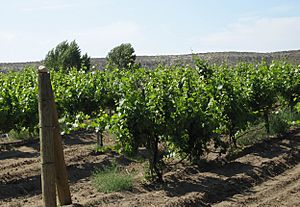Regional climate levels in viticulture facts for kids

When people grow grapes for wine, a process called viticulture, they pay close attention to the weather and climate. The climate of an area greatly affects how grapes grow and taste. To understand this better, experts use different levels of climate description. These levels help them describe the unique features of a place, often called its terroir. This can range from the climate of a huge wine region to the tiny climate around a single grape plant.
Contents
Understanding Grape Climates
Growing grapes successfully depends a lot on the weather. Different climate levels help us understand how the environment influences grapevines. These levels help grape growers make the best choices for their vineyards.
Macroclimate: The Big Picture
The macroclimate is like the overall weather pattern of a very large area. Think of it as the climate of an entire wine region, which can cover many miles. For example, a large area like the American Viticultural Area (AVA) in the United States or a French Appellation d'origine contrôlée (AOC) would have its own macroclimate. This big-picture climate includes things like how much rain an area gets each year or its average temperature.
Mesoclimate: The Vineyard's Weather
Moving to a smaller scale, the mesoclimate describes the weather conditions of a specific vineyard. This area is usually much smaller than a whole region, perhaps just a few hundred feet across. Factors like whether the vineyard is on a hill, in a valley, or near a river can create a unique mesoclimate. For instance, a vineyard on a sunny slope might be warmer than one in a shaded valley, even if they are in the same macroclimate region.
Microclimate: Right Around the Vine
The smallest climate level is the microclimate. This refers to the very specific weather conditions in a tiny space, like around a single row of grapevines or even just one grapevine. A more detailed term is canopy microclimate, which focuses on the environment right around the leaves and fruit of an individual grapevine. Things like how dense the leaves are, how much sunlight hits the grapes, or how air moves around the plant all create this tiny climate. Grape growers often manage the leaves and branches to create the best microclimate for their grapes.

